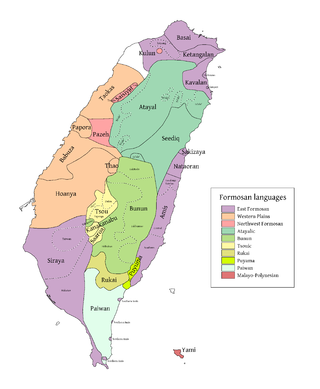Babuza language
Formosan language of the Babuza and Taokas, indigenous peoples of Taiwan
You can help expand this article with text translated from the corresponding article in Chinese. (July 2024) Click [show] for important translation instructions.
- View a machine-translated version of the Chinese article.
- Machine translation, like DeepL or Google Translate, is a useful starting point for translations, but translators must revise errors as necessary and confirm that the translation is accurate, rather than simply copy-pasting machine-translated text into the English Wikipedia.
- Consider adding a topic to this template: there are already 290 articles in the main category, and specifying
|topic=will aid in categorization. - Do not translate text that appears unreliable or low-quality. If possible, verify the text with references provided in the foreign-language article.
- You must provide copyright attribution in the edit summary accompanying your translation by providing an interlanguage link to the source of your translation. A model attribution edit summary is
Content in this edit is translated from the existing Chinese Wikipedia article at [[:zh:巴布薩語]]; see its history for attribution. - You may also add the template
{{Translated|zh|巴布薩語}}to the talk page. - For more guidance, see Wikipedia:Translation.
| Babuza | |
|---|---|
| Native to | Taiwan |
| Region | central Taiwan |
| Ethnicity | 35 Babuza, Taokas[1] |
| Extinct | 2000s[2] |
| Revival | 2020[3] |
Language family | Austronesian
|
Early form | Favorlang? |
| Dialects |
|
Writing system | Latin script |
| Official status | |
| Regulated by | Academia Sinica |
| Language codes | |
| ISO 639-3 | bzg (with Favorlang) |
Linguist List | bzg |
| Glottolog | babu1240 |
 (orange) The Babuza, Papora-Hoanya, and Thao languagese | |
 | |
Babuza is a Formosan language of the Babuza and Taokas, indigenous peoples of Taiwan. It is related to or perhaps descended from Favorlang, attested from the 17th century.
Babuza was once spoken along much of the western coast of Taiwan. Its two rather divergent dialects, Poavosa and the extinct Taokas, were separated by Papora and Pazeh.
The first commercial publication to be written in Taokas is the picture book Osubalaki, Balalong Ramut, published in 2020.[3]
See also
References
- ^ Lewis, M. Paul; Gary F. Simons; Charles D. Fennig, eds. (2016). Ethnologue: Languages of the World (19th ed.). Dallas, Texas: SIL International.
- ^ Babuza at MultiTree on the Linguist List
- ^ a b Han, Cheung (1 July 2020). "Reviving a Language on the Page". Taipei Times. Retrieved 1 July 2020.
- ^ Atlas of the World's Languages in Danger (Report) (3rd ed.). UNESCO. 2010. p. 51.
Resources
Dictionary
- Happart, Gilbertus (1840) [1650]. Dictionary of the Favorlang Dialect of the Formosan Language. Medhurst, W. H. Batavia.

Babuza language test of Wikipedia at Wikimedia Incubator
- v
- t
- e
| Formosan |
| ||||||||||||
|---|---|---|---|---|---|---|---|---|---|---|---|---|---|
| Malayo-Polynesian |
|
| Sinitic |
|
|---|
‹ The template below (Austronesian languages) is being considered for deletion. See templates for discussion to help reach a consensus. ›
 | This article about Formosan languages is a stub. You can help Wikipedia by expanding it. |
- v
- t
- e











